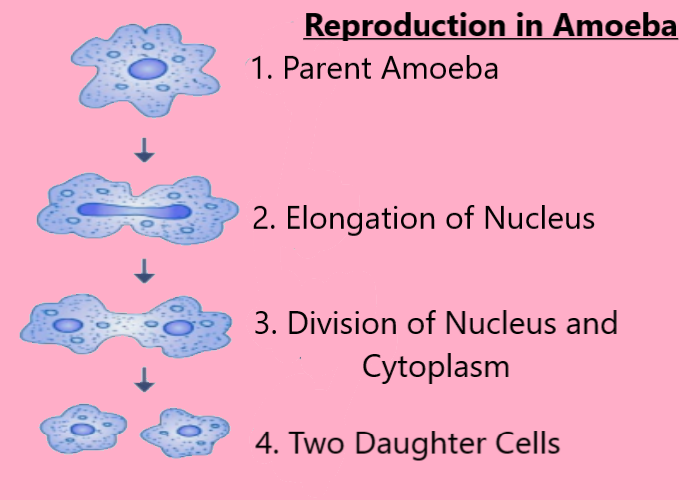
In the process of binary fission
(a)Cytoplasm divides first followed by division of the nucleus.
(b)Nucleus divides first followed by division of cytoplasm.
(c)Both nucleus and cytoplasm divide simultaneously.
(d)Cell protrudes followed by division of the nucleus.
Answer
561.6k+ views
Hint: In binary fission, the internal portion of the cell or the prokaryotic organism divides first followed by the division of the outer portion.
Complete answer:
In the process of binary fission, the nucleus divides first followed by the division of the cytoplasm. In binary fission at first, the genetic material or DNA or nucleus is divided into two daughter nuclei this is known as karyokinesis. The karyokinesis is followed by the division of the cytoplasm of the cell into two daughter cells in such a way that each daughter cell will get separate nuclei. The division of cytoplasm into two daughter cells is known as cytokinesis.
Additional Information: -In amoeba, asexual reproduction takes place by the process of binary fission.
-The binary fission takes place under favorable conditions. It takes about 33 minutes to complete the entire process of karyokinesis.
-The chromosomes become distinct during prophase and during metaphase, they are arranged at the equator.
-The chromosome divides and moves towards the two opposite poles during anaphase.
-After anaphase there comes the telophase during which a construction appears in the middle and the animal gets divided into two daughter cells.
-These cells feed and grow which usually takes three days.
-In protists, binary fission takes place in two different ways depending upon the axis of cell separation either it is transverse fission or it is longitudinal fission.
-The regular transfer fission is seen in tapeworms and scyphostome polyps.
So, the correct answer is,' nucleus divides first followed by division of cytoplasm'.
Note: -Binary fission is a method of asexual reproduction of prokaryotic organisms.
-Karyokinesis is a process of division of the nucleus into two daughter nuclei.
-Cytokinesis is the process of division of cytoplasm or the cell into two daughter cells.
-In binary fission karyokinesis is followed by cytokinesis.

Complete answer:
In the process of binary fission, the nucleus divides first followed by the division of the cytoplasm. In binary fission at first, the genetic material or DNA or nucleus is divided into two daughter nuclei this is known as karyokinesis. The karyokinesis is followed by the division of the cytoplasm of the cell into two daughter cells in such a way that each daughter cell will get separate nuclei. The division of cytoplasm into two daughter cells is known as cytokinesis.
Additional Information: -In amoeba, asexual reproduction takes place by the process of binary fission.
-The binary fission takes place under favorable conditions. It takes about 33 minutes to complete the entire process of karyokinesis.
-The chromosomes become distinct during prophase and during metaphase, they are arranged at the equator.
-The chromosome divides and moves towards the two opposite poles during anaphase.
-After anaphase there comes the telophase during which a construction appears in the middle and the animal gets divided into two daughter cells.
-These cells feed and grow which usually takes three days.
-In protists, binary fission takes place in two different ways depending upon the axis of cell separation either it is transverse fission or it is longitudinal fission.
-The regular transfer fission is seen in tapeworms and scyphostome polyps.
So, the correct answer is,' nucleus divides first followed by division of cytoplasm'.
Note: -Binary fission is a method of asexual reproduction of prokaryotic organisms.
-Karyokinesis is a process of division of the nucleus into two daughter nuclei.
-Cytokinesis is the process of division of cytoplasm or the cell into two daughter cells.
-In binary fission karyokinesis is followed by cytokinesis.

Recently Updated Pages
Master Class 12 English: Engaging Questions & Answers for Success

Master Class 12 Economics: Engaging Questions & Answers for Success

Master Class 12 Social Science: Engaging Questions & Answers for Success

Master Class 12 Maths: Engaging Questions & Answers for Success

Master Class 12 Chemistry: Engaging Questions & Answers for Success

Master Class 12 Business Studies: Engaging Questions & Answers for Success

Trending doubts
What are the major means of transport Explain each class 12 social science CBSE

Which are the Top 10 Largest Countries of the World?

Draw a labelled sketch of the human eye class 12 physics CBSE

Explain sex determination in humans with line diag class 12 biology CBSE

The pH of the pancreatic juice is A 64 B 86 C 120 D class 12 biology CBSE

Explain sex determination in humans with the help of class 12 biology CBSE




